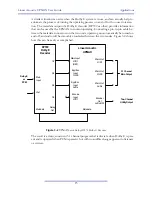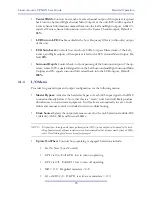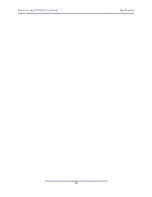
Linear Acoustic UPMAX User Guide
23
Chapter 5: Troubleshooting
The Linear Acoustic UPMAX is a very stable and reliable unit, and most problems can be
traced back to mis-wiring causing incorrect signals to be applied to the unit, or more than
likely mis-configuration. In an effort to speed troubleshooting, some common problems
and solutions are described below.
5.1
Problems and Possible Causes
One of the best troubleshooting features of the UPMAX is the hard-bypass of the audio
signals. This is useful because it allows instant removal of the unit from the signal path.
Hard-bypass can be accomplished two ways, the simplest being to remove AC power from
the unit by turning the power switch off. A less dramatic way to accomplish the same result
is to access the System Options menu and enable Master Bypass. If you are unsure of what
is happening in a particular system, simplifying the signal path is a good start and will help
isolate problems quickly.
5.1.1
Unit won’t power on
Check to make sure that the unit is connected to a live outlet (it happens...). If proper AC
voltage is being applied to the unit, remove power and check the fuse (the IEC inlet mod-
ule has a fuse compartment that can be carefully opened with a small screwdriver). If the
fuse is blown there is a spare in the holder. Install the replacement fuse, re-insert the fuse
carrier, and re-apply power.
NOTE: Replace fuses only with the same size and rating: 5mmx20mm T1AL (250V)
5.1.2
Output Audio Clicks and Pops
This could indicate that the AES Reference is missing or at the wrong sample rate (the unit
expects to be locked to 48kHz). The unit is designed to default to an internal 48kHz ref-
erence in case the external reference is removed. This allows audio to continue, but due to
the sample rate converters present on each input pair, the outputs will be asynchronous
with the inputs. The solution is to make sure that the reference is connected.
It could also mean that audio applied to the unit is not properly referenced, or that the
equipment that the unit is feeding is not properly referenced. Using the master bypass
function of the unit is a helpful way to troubleshoot this issue.
Summary of Contents for UPMAX
Page 6: ......
Page 10: ...Linear Acoustic UPMAX User Guide 4...
Page 14: ...Linear Acoustic UPMAX User Guide Introduction 8...
Page 18: ...Linear Acoustic UPMAX User Guide Connections and Quick Setup 12...
Page 28: ...Linear Acoustic UPMAX User Guide Detailed Operation 22...
Page 33: ...Linear Acoustic UPMAX User Guide Specifications 27...
Page 34: ...Linear Acoustic UPMAX User Guide Specifications 28...
Page 35: ...Linear Acoustic UPMAX User Guide Specifications 29...
Page 36: ......








































